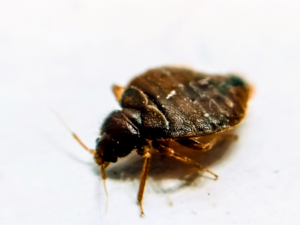Home / Blog / How to Follow Integrated Pest Management Principles in Your Home
How to Follow Integrated Pest Management Principles in Your Home

Scientifically reviewed by Daniel Baldwin, BCE, CCFS, CP-FS
-Published on March 31, 2023
-Updated on September 15, 2023
Pests can be a real nuisance in any home. They cause property damage, food contamination, and even spread diseases. While traditional pest control methods may provide quick relief, they often involve harsh chemicals that can harm you, your family, and the environment. That’s why it’s important to adopt a more sustainable and environmentally-friendly approach to pest control, such as integrated pest management (IPM).
In this blog, we’ll discuss the principles of IPM and how you can apply them in your own home. This way, you can effectively manage pests while minimizing the use of chemicals. Whether you’re dealing with ants, bedbugs, rodents, or any other type of pest, you’ll learn practical tips and strategies for preventing and managing infestations in a safe, sustainable way.
What is Integrated Pest Management?
Integrated Pest Management (IPM) is an effective, environmentally sensitive approach to pest control. It originated in the agricultural production world, but its principles have since been applied to residential and commercial situations.
IPM is not a single pest control method but a series of pest management evaluations, decisions, and control measures based on a comprehensive understanding of pests’ life cycles and how they interact with the environment.
Why should you follow IPM principles in your home?
When pests attack your home, IPM is a smart and cost-effective method. It’s all about preventing pests from getting in and only using chemicals as a last resort.
Unlike traditional pest control methods that rely heavily on chemicals, IPM takes a more holistic approach that considers the root causes of pest infestations and implements a combination of preventive measures, monitoring, and targeted treatments to manage pests effectively.
There are many benefits to following integrated pest management methods. You’ll soon find that pest infestations are less likely to occur and less severe if they do arise. IPM also saves you money compared to traditional chemical pest control methods. So, by using IPM, you can keep your home pest-free while being kind to the environment and your wallet!
A step-by-step guide to implementing Integrated Pest Management principles in your home
There are many easy and actionable steps you can take to integrate IPM into your daily life and solve your pest woes. The four main ones are setting “action thresholds,” monitoring and identifying pests in your home, preventing them from entering your property, and taking targeted action when necessary. Let us tell you more about each one below.
-
Know your “action threshold”
Before doing anything about pests in your home, it’s important to know when it’s actually necessary to take action. Seeing one pest doesn’t always mean you must take control measures. It’s very common to spot pests in cities, and it doesn’t mean anything about the situation in your home.
That’s where the “action threshold” comes in — the point where the pest populations or other environmental conditions tell us we need to act. Deciding where the threshold lies is the first step in implementing Integrated Pest Management, and it will guide your future pest control decisions.
-
Spot the culprits
Not all creepy crawlies or plant life require control measures. Some are harmless, and some are even helpful! The key to making the right decisions is properly monitoring for pests and accurately identifying them. This will help you avoid using pesticides unnecessarily or using the wrong kind of chemicals, minimizing risks to your health and the costs involved.
-
Stop pests at the source
The first line of defense against pest infestations is to make your home, lawn, or indoor space less attractive to them. You can implement preventive measures, such as proper sanitation practices, exclusion techniques (e.g., sealing cracks and crevices), and reducing harborages (places where pests can hide). These methods are effective, cost-efficient, and better for people and the environment.
-
Choose the right solution
Once monitoring and identification tell us that we’ve reached the “action threshold,” you need to evaluate the best control methods based on effectiveness and safety.
At first, try the least risky methods, such as releasing pheromones to disrupt pest mating or using mechanical controls like trapping or weeding. If these techniques aren’t working, it’s time to bring in the experts. Reach out to professional extermination companies that are familiar with IPM practices and offer a targeted approach.
At Hawx Pest Control, we’ll identify pests first and use specific sprays, and only treat with broad-spectrum pesticides as a last resort.
Real-life examples of residential Integrated Pest Management approach you can take
Integrating IPM practices in your daily life can be done in both apartment and house living. Start with the same basic steps, no matter your living situation, and then take informed actions.
1. Identify your pest problem
Start by surveying your home and seeing if you can find any pests. If you spot some, can you identify what they are? Cooperative Extension Services and pest management professionals can help you understand what type of infestation you are dealing with.
2. Understand the situation
Do you see a single, isolated critter, or do you have a full-blown infestation in your home? What is attracting these vermin to your property, and how are they getting in? Chances are you can take many measures to prevent it and ensure they won’t want to turn from temporary visitors to permanent residents.
3. Take preventative actions
To make your apartment or indoor space less welcoming to pests, consider the following:
- Closing up any entrance and exit points, like windows, doors, and piping
- Removing clutter around the home
- Getting rid of any possible food sources
- Keeping the humidity relatively low to reduce pests
- Vacuuming carpets and rugs regularly to remove crumbs, bugs, and eggs
- Checking items coming into your home for hitchhiking pests
- Using a dryer with clothing and bedding to kill eggs, larvae, and bugs
If you have a garden, then don’t forget to apply IPM principles to your outdoor area too. Some examples are:
- Choose plants that are naturally resistant to pests common in your area, and shop at reputable retailers to reduce the risk of bringing in pests
- When purchasing plants, inspect them thoroughly for signs of pests or diseases
- Provide adequate nutrition, water, and care to your plants to help them fight off pests and diseases
- Don’t overdo it with water, as too much watering can actually encourage the growth of pests and diseases
- Use mulch to regulate moisture levels and create a healthy environment for your plants
- Tackle weeds and keep them under control, as they can provide a safe haven for pests
- If you spot an infested plant, remove it promptly to stop the spread of pests or diseases
- Mix it up by rotating your plants every 3-4 years to prevent pests from getting comfortable in any one area of your garden
Take charge and stay safe with Integrated Pest Management
At Hawx Pest Control, we strongly believe that Integrated Pest Management is the way to go when it comes to pest control in your home. Taking a proactive approach that combines preventive measures, monitoring, and targeted treatments can control pests while keeping your family, home, and the environment safe from harmful chemicals. With an IPM program, you can enjoy a pest-free home responsibly and sustainably and save money along the way!
Related Articles
Visit our blog to learn more.
→








